BREAST LIFT
The problem: Due to the atrophy of the mammary glands as a result of the fluctuation in body weight during puberty or the hormonal changes after pregnancy, having a baby and nursing the breasts can become sagging and hanging. This phenomenon appears mainly because of the weakness of the connective tissues. The breast’s system of ligaments slackens and its skin becomes loose. This deformation can occur in various degrees of severity.
The intervention: The operational methods of a breast lift depend on the degree of sagging, the age of the patients and her build. In each case we endeavour to make the results long-lasting and leave the least amount of scars possible. Thus the circular incision at the edge of the areola can be supplemented with vertical and perpendicular incisions made in the lower part of the breast (reverse T-shape technique) depending on the type of sagging. The operation can be carried out under local anaesthetic or in narcosis. After the operation a one-day hospital observation is necessary.
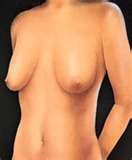
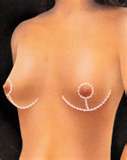
BREAST REDUCTION
The problem: The exaggerated growth of the mammary glands of a female breast, the asymmetry due to unequal development of the bilateral glands and the sagging of the breasts caused by their weight can result in a ‘large breasts’ symptom causing physical complaints (e.g. a pain in the back) and psychic disturbances.
The intervention: There are a number of breast reduction methods. When choosing the most suitable method, we have to take it into consideration if the patient has several children and does not want to have any more or she does not have any children and requires a breast reduction. The build of the patient and the size of the breasts also influence our decision. Most often we use the so-called reverse T-shape breast surgery. After the operation a pressing bandage holding the breasts has to be worn for a period specified by the surgeon. In case of a smaller reduction the operation can be carried out under local anaesthetic, however, most often we do it in narcosis.

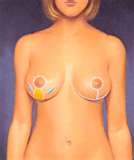
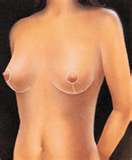
BREAST ENLARGEMENT
The problem: The lack of the mammary glands, their atrophy, the unequal development of the bilateral glands can result in a ‘small breasts’ symptom causing psychic disturbances.Physical factors can also be the cause of small breasts in case of women who does not have a child, however, the atrophy of the bilateral glands due to hormonal effects after having a baby is also a frequent phenomenon.
The intervention: The cosmetic breast enlargement operation means the implantation of alloplastic materials (endoprosthesis). The process of implanting good quality implants with a CE sign has no alternative at the moment. The unjustified fears resulting from the implantation of silicone prostheses are dissolved by the consensus declaration of 28th June 1996 of the European Committe on Quality Assurance and Medical Devices in Plastic Surgery which in 9 articles summerizes what harmful effects a silicone implant does not have, based on several million follow-up examinations. The choice of the type and size of the endoprosthesis is to be discussed with the surgeon carrying out the operation. During the operation the missing volume of the breast is supplied by the implant. This can be implanted under the muscles or between the muscles of the chest and the glands. The surgical incision can be made in the armpit, at the edge of the areola or transversely through the nipple, however, most often under the breasts. The small surgical incision can be united with an inner cosmetic row of stitches inside the skin and this way only a barely visible scar remains in an optimal case. Occasionally, a suction pipe is inserted beside the prosthesis for one day to remove the tissue-fluids and blood. After the operaton a pressing bandage holding the breasts has to be worn for a period specified by your surgeon. The operation can be carried out under local anaesthetic and in narcosis as well. After having a breast implantation it is recommended to spend one day at the hospital. The physician will tell the patient when she will be able to play sports again, for how long and which parts of the day she has to wear a bra and when she can wash the surgical area.
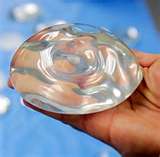

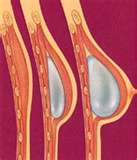
SURGICAL SCARS
Wounds received during a surgical intervention heal with a scar on the skin and in the tissues under the skin. The scar is never equivalent to the destroyed tissues because its vascular bed and nerve functions are quite bad, it has no defence system and cannot tackle with mechanical stress. During our surgical interventions we immediately close the wounds left on the integument with a gentle technique, thus expectedly only a thin, soft, barely visible scar remains which affects neither the functions nor the look. The normal formation of scars can be influenced by many factors (age, skin type, part of the body, tension lines, pregnancy, hereditary factors, infection, allergic reactions, haematoma, physical-chemical irritation etc.). The formation of the scar can take a while and its maturation can last for a year during which it softens, whitens and becomes similar to its surroundings. During this period its surgical correction is advised only in special cases (burnt skin, ‘wrong direction’ scars). Certain people are susceptible to having their surgical wounds heal with a so-called pathological scar in spite of the most gentle surgical technique.
An atrophic scar has its corium missing from its thin, flattened base and frequently occurs when taking steroids, during pregnancy (stripes and striae are like this!) and with white skin types with a thin corium. The reason of its formation is the underproduction of colloid fibres within the scar, and as a consequence, the skin becomes vulnerable here and the scar very often widens.
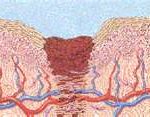
A hyperatrophic scar bulges out from the skin and is often redder than its surroundings. Later its colour fades, the scar can flatten and can become atrophic during its maturation. It is frequent mainly during puberty, with young adults and on certain parts of the body (in the triangle between the shoulders and the sternum – cleavage). People with a thicker corium and a darker skin type are more susceptible to it. The same is true for a celoid as well, however, it bulges out from the scar to an extent that it spreads like candle-wax along its edges and will not regress. Patients often complain of itching and burning sensations on this area. To avoid celoids the surgeon has to make incisions in accordance with the tension lines of the skin and the tension of the muscles, use a tissue-friendly surgical technique and closure of the wound. In many cases the formation of celoids cannot be avoided even with these precautions and further treatments are needed because of the pathological scar.
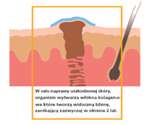
Among the possible alternatives we can mention the surgical excision of the scar, then its tension-free merging with the stitches or adhesive tape and finally the soft x-ray irradiation (DERMOPAN) after the operation. Irradiation affects only the upper layers of the skin and does not enter the deeper tissues, thus it does not overburden the body. Within 6 hours after the operation it is recommended to be started and repeated 4 to 5 times 1 or 2 days later.
The chance of recurrence can be decreased with the use of silicone ointments or plasters which are advised to be left on the scar for months in accordance with the recommendations of the producers. Wearing compression clothes designed for various parts of the body can reduce the regeneration of the celoid. Ultrasonic and Soft laser irradiations are among the additional treatments. If a hyperatrophic scar or a celoid develop in spite of all our efforts, we can be forced to use a injection therapy (steroid and anaesthetic) which are recommended to be repeated in every 2 months if it proves to be successful.
What can you do for an optimal scar formation after the operation?
The most important thing is that you, following the instructions, should take care of the cleanness of the bandage, protect it from humidity (sweat, water), keep a peaceful lifestyle to minimize the tension of the scar. You have to appear at each control examination, and if at any time you notice a haemorrhage, a red spot, pain or fever, see your surgeon at once! The time of taking out the stitches does not correspond to the healing of the wound and the final formation of the scar, therefore it is very important to ease the scar (leuko strip plaster) and neglect sports for 1 or 2 months. Massaging the scar and treating it with antiphlogistic ointments (calendula, aloe vera) have beneficial results. The time of taking a shower is recommended to be discussed before the patient goes home since it can often precede the taking out of the stitches. After breast operations (silicone prosthesis, breast lift, breast reduction, oncological surgery) wearing a comfortable, yet flexible sports bra (top) night and day is advised for 3 months in order that the scars and the inner stitches can be eased and thus we can achieve the wished shape of the breasts and barely visible scars. Using cosmetics on the face is not recommended before and after an operation because every chemical material can influence the formation of scars.
ABDOMINOPLASTY
The problem: After having a baby or a greater fluctuation in body weight the looseness of the abdominal skin and the wall muscles makes this intevention reasonable.
After having a baby the skin of the abdomen becomes loose, in many cases it hangs down like an apron and the straight abdominal muscles move away from each other. This state cannot be changed even with a strict diet or sports.
The intervention: During the operation we treat two alterations causing aesthetic and functional problems. Dermolipectomy removes the excess skin and fat by removing the skin and the fat under the skin defined by the incisions which are made above the navel and 3 inches above the mons pubis and which meet near the hipbone, after an incision has been made around the navel. A new hole is cut for the navel on the tightened skin. A drain is temporarily inserted in the surgical area so that the discharge accumulated can be derived. It can be removed in a few days. The wounds are closed with a glover’s suture using cosmetic stitches, thus no ladder stitch marks will be left on the skin. The looseness of the muscles of the abdominal wall is corrected by sewing the straight muscles together. Abdominoplasty is always performed in narcosis. A flexible belly-band is recommended to be used after the operation.

FACIAL PLASTIC SURGERY

The problem: With aging the skin of the face becomes thinner, loses its flexibility and becomes loose. If this is accompanied by a significant change in body weight, this phenomenon can appear earlier. What are these typical deformations? Transversal wrinkles can develop on the forehead. Fine radial wrinkles can appear around the upper and the lower lips. The skin of the neck becomes loose and hanging, which can be made even worse by the accumulating fat of the double chin. The reason for all these is the atrophy of the epidermis of the skin, the change in the number and quality of the collagen fibres and the atrophy of the mimic muscles.
The intervention: If possible, in many cases only a smaller intervention is performed. With the help of proper, long-life, good quality filling material the filling in of the wrinkles can be effective. The shape of the lips or the enhancement of their plumpness can be achieved with both operation and filling injections. Both interventions are carried out under local anaesthetic within the framework of our outpatient services. In more advanced cases the best result can be achieved with an operation technique called face lift during which we can perform interventions in the deeper muscle structures besides cutting out the excess skin and tightening the surface of the skin in order to achieve long-lasting results. The before-mentioned alternatives can be combined with each other in accordance with the actual problem and expectations. Smaller operations and interventions can be carried out under local anaesthetic within the framework of our outpatient services. A full face lift can be performed under local anaesthetic or in narcosis and requires a one-day hospital observation.

OTOPLASTY
The problem: The ears stick out more than normal because of the positioning of the pinna: its prominence or low-set positioning are frequent problems.
The intervention: During the operation an incision is made at the back of the pinna and a portion of the cartilaginous part of the ear is removed, then the curve of the ear is corrected. After that with the help of stitches the cartilage is fixed in a position so that the pinna clings closer to the skull. The operation is usually done with local anaesthetic, then a proper circumferential bandage is applied. After a short period of observation the patient can go home.
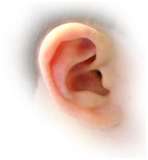
RHINOPLASTY
The problem: The inborn or acquired (injury, operation) deformities of the nose can cause aesthetic and often functional complaints. The most common problems are the big and hooked, twisted or flat nose or the deformations of the bridge of the nose. The twisting of the bridge is very often accompanied by the deviation of the nasal septum. Rhinophyma is a typical benign alteration of the nose which occurs mainly at an elderly age and means the diffuse thickening of the skin of the nose accompanied by sebaceous gland hyperplasia. The inborn deformations of the nose are determined by genetic codes. A nose which is often nice at an early age can become big, hooked or twisted after puberty.
The intervention: The cosmetic nose surgery means the reduction of the bony and cartilaginous structure of the nose without damaging the skin of the nose, the reconstructing of the elements and their fixation. If any of the structures needs enlargement, the completion is done with closed rhynoplasty. In case of secondary rhynoplasty or the correction of developmental abnormalities we use the so-called open rhynoplasty. If a deviation of the nasal septum causing respiratory disturbances is also diagnosed, it is fixed as a preliminary operation or together with the correction of the exterior part of the nose. Rhynoplasty, if coupled with nasal septum surgery, is always carried out in narcosis. The minor plastic interventions on the exterior part of the nose can be done with a nerve block or under local anaesthetic. In case of narcosis a one-day observation is necessary.

BLEPHAROPLASTY
The problem: With aging the skin of the eyelids becomes thinner and radial wrinkles called crow’s feet develop, starting from the lateral canthus. The skin of the upper and the lower eyelids becomes withered and loose. The wrinkles of the upper eyelid reach the row of eyelashes or even hinder eyesight by overreaching them. Above and below the lateral and the medial canthi a swelling (bags) can appear that pushes the eyelid out.
The intervention: During the operation the loose, wrinkled skin of the upper and lower lids as well as the fatty tissue pushing the lid out are removed. Blepharoplasty is usually carried out under local anaesthetic. If the patient is cooperative enough, the blepharoplasty does not require hospital care. After the operation has been performed and an observation of a few hours has been carried out, the patient can go home.
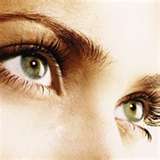
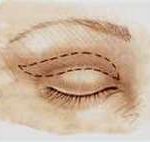
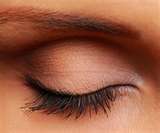
LIPOSUCTION
The problem: The multiplex or localized exess fat tissue on any part of the human body. It can appear in the form of contour irregularities caused by fat deposits on the face, the neck, the arm, the breasts, the stomach, the trunk, the inner and outer surface of the thighs, the knees and the ankles.

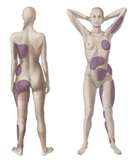
The intervention: Liposuction does not aim at body weight reduction but the removal of the fat accumulation causing troublesome contour irregularities. A significant part of the fat tissue excess is removed with the help of vacuum. After having made a 2-3 mm-long incision on a hidden place, metal suction pipes of adequate size and shape are inserted into the fat tissue under the skin and the necessary amount of fat is removed from the designated spot. The duration of the operation depends on the size of the body area to be treated and the thickness of the fat tissue. If one or two areas are treated, the use of local anaesthetic is enough. If more than two and larger areas are concerned, then narcosis is advised after which one night must be spent at the hospital. After the operation wearing a flexible pressing bandage or a corset is recommended for a period of time advised by your physician. Internal haemorrhage in the skin, the swelling of the treated area or roughness on the surface of the skin can exist for 1 or 2 weeks. The final results will be visible after 2 or 3 months.
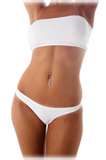
Intimate small lip plasty
The change in the aesthetic views of our age concerns even the intimate parts of our body. The overdeveloped small lips disturb a lot of ladies, causing psychic problems. The solution is an operation which can be carried out even in an ambulant way, during which we remove the area causing the problem, restoring the desired form and size. The treatment at home consists of disinfectant washings at home which must be done several times a day. The healing takes place in 2-3 weeks. Sexual activities must be ceased during that time. Two or three months are necessary to shape the final form and for the entire sensory function to return.

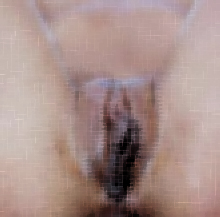
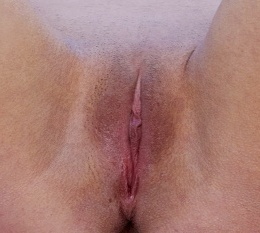
FILLING TREATMENT
The primary goal of the wrinkle-filling product injection is to accurately deliver sunstance to the area to be treated and so it may penetrate into the surrounding tissues, which can restore facial volume, redefine and augment lips and repair cutaneous depressions, it can also revitalise the dermis, restore skin tone, elasticity and hydration.
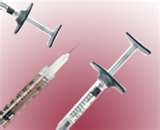
EQUAM, the European and International Committee for Quality Assurance, Medical Technologies and Devices in Plastic Surgery, suggests the use of non-permanent, bio-degradable wrinkle-filling products preferably.
The components of the non-permanent wrinkle-fillers can be hyaluronic acid, collagen, lactic acid and dextran derivatives. The great advantage of hyaluronic acid is that it is highly biocompatible, that is the structure of hyaluronic acid is vitrually the same as that of the naturally present hyaluronic acid in the skin so it will cause no tissue sensitivity. With time the crystal-clear hyaluronic acid will be fully absorbed and broken down. The treatment can be corrected and repated several times.
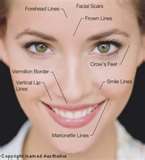

LIPTHICKENING
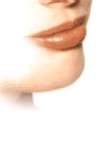
We use hyaluronacid to make the lips voluptuous and full, the same acid used filling the skin naturally, too, so it isn’t a foreign material to the body. After being filled in it is built in the tissues, it binds water and this way it mades the treated area filled and tight. Its infulence lasts 6-12 months, its great advantage is that it is the same component with the tissue, it degrades completely and it is absorbed, it does not cause remaining alterations or inflammatory reactions. Its application can be repeated if necessary, it can be corrected. We carry out the treatment in local anaesthesia. The spectacular effect can be felt immediately. After the intervention a slight swelling or sensitivity evolves at times which ceases in some days.
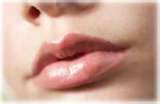
BOTOX TREATMENTS
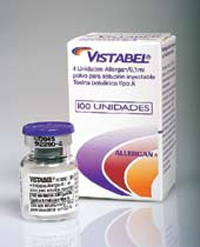 With time, with everybody wrinkles take shape and besides filling the botox treatment is a proved way to treat these
With time, with everybody wrinkles take shape and besides filling the botox treatment is a proved way to treat these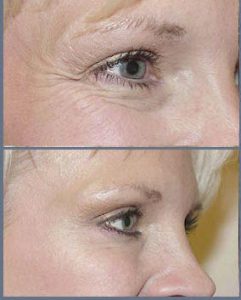 wrinkles with the use of clostridium botilinum’s exsotoxin. This product is developed into cosmetic aim and it is accepted in our country and placed on the market under the name Vistabel. The product is peripherally musclerelaxant, its leads to temporary and reversible myoparalisis and to smoothing the wrinkles. We use the Botox treatment to stop the wrinkles in different areas of the face and the neck. The toxin degrades in a certain time its effect is provisional, in most cases it lasts half a year. Then the treatment can be repeated. It is indispensible for its application the exact anatomic knowledge and the suitable practice. Our results are proved by the great number of returning patients.
wrinkles with the use of clostridium botilinum’s exsotoxin. This product is developed into cosmetic aim and it is accepted in our country and placed on the market under the name Vistabel. The product is peripherally musclerelaxant, its leads to temporary and reversible myoparalisis and to smoothing the wrinkles. We use the Botox treatment to stop the wrinkles in different areas of the face and the neck. The toxin degrades in a certain time its effect is provisional, in most cases it lasts half a year. Then the treatment can be repeated. It is indispensible for its application the exact anatomic knowledge and the suitable practice. Our results are proved by the great number of returning patients.
